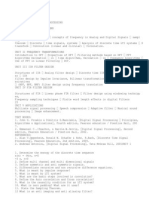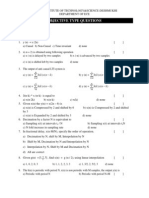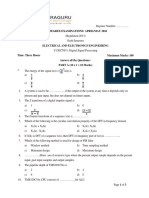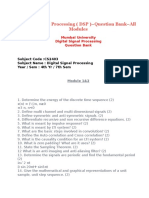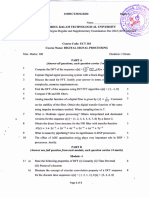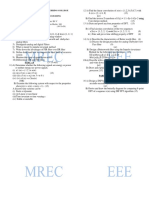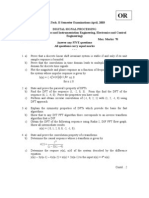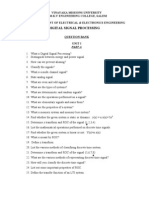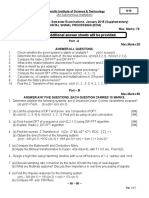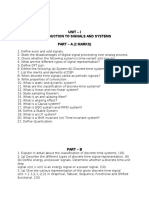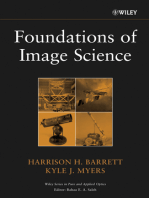Question Paper Code:: Reg. No.
Uploaded by
DhariniJeevanandamQuestion Paper Code:: Reg. No.
Uploaded by
DhariniJeevanandamReg. No.
Question Paper Code : 11295
Fifth Semester
Electrical and Electronics Engineering
EC 2314 DIGITAL SIGNAL PROCESSING (Regulation 2008) Time : Three hours
Answer ALL questions PART A (10 2 = 20 marks)
2. 3. 4. 5. 6. 7. 8.
What is known as Aliasing? What is meant by ROC?
Obtain the Discrete Fourier series coefficients of x (n ) = cos wn . What is the relation between DFT and Z transform? Draw the butterfly diagram for DITFFT. What are the special features of FIR filters? What is meant by prewarping? Mention the features of DSP processor. What is the condition for linear phase in FIR filters? PART B (5 16 = 80 marks)
9.
10.
31
31
1.
Define sampling theorem.
31 5
B.E./B.Tech. DEGREE EXAMINATION, APRIL/MAY 2011
Maximum : 100 marks
11.
(a)
(i)
Check whether the following is linear, time invariant, casual and stable y (n ) = x (n ) + nx (n + 1 ) . (8) Check whether the following are energy or power signals. (1) (2)
1 x (n ) = u (n ) 2
n
(ii)
x (n ) = Ae jw 0 n .
Or (b) (i) (ii)
Describe in detail the process of sampling and quantization. Also determine the expression for quantization liner. (10) Check whether the following are periodic (1) (2)
x (n ) = cos( 3n )
x (n ) = sin( 3 n ) .
12.
(a)
(i)
Determine the Z transform of (1) (2)
x(n) = a n cos w0 n u (n) .
x (n ) = 3 n u (n ) .
5
Or 2
(ii)
Obtain x (n ) for the following :
X (z ) = 1
1
1 1 .52
for ROC : | z | > 1,
31
+ 0 .52 2
| z | < 0.5 , 0 .5 < | z | < 1 .
(b)
(i)
Determine the linear convolution of the following sequences
x 1 (n ) = {1, 2, 3, 1 } x 2 (n ) = {1, 2, 1, 1 }.
31
(ii)
Obtain the system function and impulse response of the following system y (n ) 5 y (n 1 ) = x (n ) + x (n 1 ) . (10)
31 5
(8)
(6)
(5) (3)
(8)
(6)
11295
13.
(a)
(i)
Explain the following properties of DFT. (1) (2) (3) Convolution. Time shifting Conjugate Symmetry. (10) (6)
Or (b) (i) (ii)
Explain the Radix 2 DIFFFT algorithm for 8 point DFT. Obtain the 8 point DFT using DITFFT algorithm for
14.
(a)
(i)
x (n ) = {1, 1, 1, 1, 1, 1, 1, 1 } . Realize the following using cascade and parallel form .
H (z ) = 3 + 3 .6 z 1 + 0 .6 z 2 . 1 + 0 .1 z 1 0 .2 z 2
(ii)
Explain how an analog filter maps into a digital filter in Impulse Invariant transformation. (4)
(b)
(i)
Using Hanning window, design a filter with
Assume N = 7 . (ii) 15. (a)
31
Hd ( e jw ) = e jzw =0
5
Or Or 3
w 4 4 . | w| 4
Write a note on need and choice on windows.
Explain in detail the architectural features of a DSP processor.
(b)
31
Explain the addressing formats and functional modes of a DSP processor. (16)
31 5
(ii)
Compute the 4 point DFT of x (n ) = {0 , 1, 2, 3 }.
(8)
(8)
(12)
(12) (4) (16)
11295
You might also like
- Bharathi Education Trust G. Madegowda Institute of Technology (Gmit)No ratings yetBharathi Education Trust G. Madegowda Institute of Technology (Gmit)10 pages
- Cs2403 Digital Signal Processing Anna University Imporant Questions Two Marks and 16 Marks Question BankNo ratings yetCs2403 Digital Signal Processing Anna University Imporant Questions Two Marks and 16 Marks Question Bank8 pages
- Question Bank For Digital Signal ProcessingNo ratings yetQuestion Bank For Digital Signal Processing11 pages
- Ect303 Digital Signal Processing, December 2022No ratings yetEct303 Digital Signal Processing, December 20223 pages
- 2022 Set A PYQ Paper - Digital Signal Processing PYQ Paper For Sem V Uploaded by Navdeep Raghav (DU Academic Corner)No ratings yet2022 Set A PYQ Paper - Digital Signal Processing PYQ Paper For Sem V Uploaded by Navdeep Raghav (DU Academic Corner)4 pages
- Fundamentals of Digital Signal Processing (Aeie 3104)No ratings yetFundamentals of Digital Signal Processing (Aeie 3104)4 pages
- Digital Signal Processing R13 Previous Papers100% (1)Digital Signal Processing R13 Previous Papers5 pages
- EEE-DSP QB-unit1-Unit5 (2m and 16m QSTN Only)No ratings yetEEE-DSP QB-unit1-Unit5 (2m and 16m QSTN Only)10 pages
- Applied RVE Reconstruction and Homogenization of Heterogeneous MaterialsFrom EverandApplied RVE Reconstruction and Homogenization of Heterogeneous MaterialsNo ratings yet










